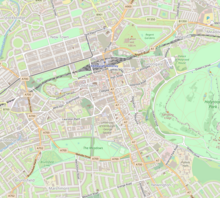Surgeons' Hall, Edinburgh

Surgeons Hall Museum
|
|
| Established | 1697 |
|---|---|
| Location | Nicolson Street, Edinburgh |
| Coordinates | 55°56′48″N 3°11′07″W / 55.9467°N 3.1853°W |
| Director | Chris Henry |
| Public transit access | Lothian Region buses 3,5,7,8,14,29, 30, 31,33,37, 47, 49 to Nicolson Street |
| Website | www |
Surgeons' Hall in Edinburgh, Scotland, is the headquarters of the Royal College of Surgeons of Edinburgh (RCSED). It houses the Surgeons' Hall Museum, and the library and archive of the RCSED. The present Surgeons' Hall was designed by William Henry Playfair and completed in 1832, and is a category A listed building.
Surgeons' Hall Museum is the major medical museum in Scotland, and one of Edinburgh's many tourist attractions. The museum is recognised as a collection of national significance by the Scottish Government.
The museum reopened in September 2015, after being closed for an eighteen month period of redevelopment.
The Museum at Surgeons Hall, Edinburgh dates from 1699 when the Incorporation of Edinburgh Surgeons announced that they were making a collection of ‘natural and artificial curiosities’. and advertised for these in the first edition of a local paper, the Edinburgh Gazette. Daniel Defoe, an early visitor in 1726, wrote in his Tour thro' the whole Island of Great Britain that the 'chamber of rarities' contained many curious things too numerous for him to describe. Much of this early collection was given to the University of Edinburgh in the 1760s.
By the early years of the 19th Century, the Incorporation had received a Royal Charter to become the Royal College of Surgeons of Edinburgh. The College saw its primary role as the teaching of anatomy and surgery, the training of surgeons, and examination of their acquired knowledge. Anatomy and pathology specimens were crucial to that function. The museum expanded dramatically with the acquisition of two large collections. John Barclay, a successful anatomy demonstrator in the extramural school of medicine donated his collection, while Sir Charles Bell, Professor of Surgery in the University of London and latterly in the University of Edinburgh sold his collection to the museum. These collections were much too large to be housed in the original 1697 Surgeons' Hall, and so the surgeons commissioned the leading Edinburgh architect William Playfair to build the present day Surgeons Hall, which opened in 1832. At first the entire upper floor of the building was devoted to the museum collections, which were open to the public and attracted large visitor numbers. Throughout the 19th and early 20th century the collection expanded as it became customary for surgeons and pathologists to donate not only specimens which they regarded as interesting or instructive, but surgical instruments and equipment. With the great scientific and technical advances of the time, the museum began to acquire anaesthetic equipment, histology slides, X-rays and photographs.
...
Wikipedia

